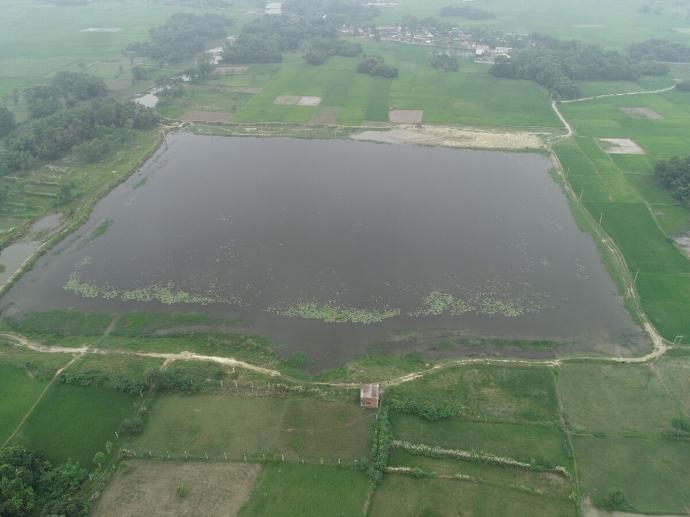Pond System

Pond system cultivation method of makhana or fox nut or Gorgon nut is one of the oldest and the traditional method use by makhana growers in different parts of the world, especially in India.
Under this method, direct seed sowing is done for new water bodies. This is a tedious and time consuming process. In case of old ponds which have already been harvested, seed sowing is not required , as leftover seeds act as the planting material for the next crop.
Types of Seed Sowing
Direct Sowing
In case of direct sowing, healthy makhana seeds are broadcasted on the upper surface of the water bodies. Seeds are usually sown in the month of December and the quantity of seeds sown is between 75-95kgs.
Its takes between 30-45 days for the seeds to germinate at the bottom of the pond. After the germination, the makhana plantlets come up to the upper surface of the pond or water body. Farmers ensure that there is an optimum distance of atleast 1 x 1 metre between each row and also between each plant. This distance is maintained by timely thinning of the extra plants.
Transplant Method
Another method of sowing makhana seeds is to transplant healthy makhana plantings during the period of March-April again with an optimum spacing of 1 x 1 metre between each row and also between each plant.
Once the plants grow, in nearly two months’ time, the plants start to bear purple flowers. In addition, nearly 40-45 days after flowering of the plants, it bears fruits and matures.
It is always seen that entire part and fruit of Makhana plant are thorny. Once the full maturity is reached, the fruits soften up, become spongy and then start to burst. During the initial 2-3 days of bursting, the fruits then begin to settle down into the bottom of the pond or water body.
It takes nearly 4 to 6 months till flowers are fully developed and fruits are fully matured. Later on, during the month of September and/or October , all the accumulated makhana seeds are collected from the bottom of the water bodies. The seeds that remain uncollected from the water bodies automatically germinate again in the next season.
Stages of Production
The pond system of cultivating and growing makhana includes the following stages. It is a laborious process with the farmers working during the day up to knee-deep and muddy water. Following are the stages:
Stage 1 : Seeds are sown in waterbodies
Stage 2: Seeds germinate and grow in the pond or other water body
Stage 3: Makhana plant grows and bears flowers
Stage 4: Plant matures and bears fruit
Stage 5: Plant is harvested by making use of traditional equipment including Kara & Ganjaa
Stage 6: Seeds are graded as per size, are pre-heated and tempered.
Stage 7: The whole processing takes place
Stage 8: Product is packed and marketed
Cost Management and Economics of Pond System of Makhana Cultivation
There are a number of farmers who still continue to undertake the pond system of makhana cultivation as they lack resources required for modern day methods and also lack the monetary power to purchase the latest farming equipment and machines.
The pond system of cultivation is long and laborious and has a low annual yield per hectare when compared to the field system of cultivation. Also the net return on investment is also low when compared to the other cultivation system.
In field system total yield and net return is higher than pond system. Farmers without the ownership of the pond is one of the major constraints for production of makhana through this traditional method. Also, the lack of processing machineries makes the role of human labour more extensive to the processing process.
All the above factors make makhana very costly. Though the cost will vary due to type of grade, form of makhana, technique used to make makhana, processing used to mae the finishes product, the supply chain channel used, the marketing technique used etc.
Impact of Pond system on Fish Ecosystem
Pond system of cultivation has a very positive impact on the fish eco system. Farmers with the help from government, has introduced successful techniques that synchronize the makhana cultivation with fish so that both are mutually benefitted.
It is interesting to know that the decayed parts of the makhana plant release important nutrients into the ponds which further enhances the plankton population. Bottom-dwelling fish species like Carp and mrigal feed on the plankton growth and in turn also end up diminishing the makhana plant pests.
Integrated fish farming is very popular in India and is a successful way of producing agricultural crops in the fish farms with fish as the main product. The biggest benefit of such an integration farming technique is that it combines aquaculture with agriculture, dairy, duckery, poultry and horticulture recycles the organic wastes derived from integrated system. This symbiotic relationship between farming of flora and fauna improves the production without creating an adverse effect on the environment. It has also been observes that different types of fish including common carp, silver carp, catla, rohu and grass carp also gained weight owing to nutritive elements released due to makhana sowing in the water bodies.
Cost-benefit analysis of integrated farming
Looking at the cost Vs benefit relationship of the integrated farming and clubbing of makhana with fish, gives very good results. Research has shown that even though the initial cost may be high owing to clubbing both fish and makhana, but in the longer run, the benefit far outweighs the cost.